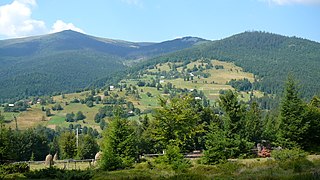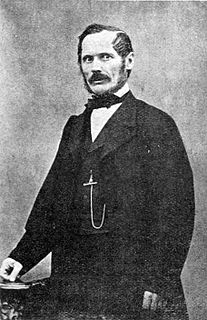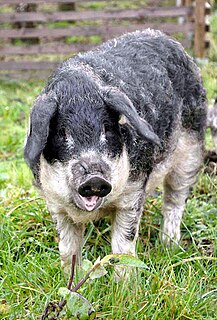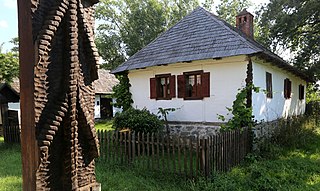Related Research Articles

Transylvania is a historical region in central Romania. To the east and south its natural border is the Carpathian Mountains, and to the west the Apuseni Mountains. Broader definitions of Transylvania also encompass the western and northwestern Romanian regions of Crișana and Maramureș, and occasionally Banat.

Banat is a geographical and historical region that straddles Central and Eastern Europe and which is currently divided among three countries: the eastern part lies in western Romania ; the western part of Banat is in northeastern Serbia ; and a small northern part lies within southeastern Hungary.

The coat of arms of Romania was adopted in the Romanian Parliament on 10 September 1992 as a representative coat of arms for Romania. It is based on the Lesser Coat of Arms of the Kingdom of Romania, redesigned by Victor Dima. As a central element, it shows a golden aquila holding a cross in its beak, and a mace and a sword in its claws. It also consists of the three colors which represent the colors of the national flag. The coat of arms was augmented on 11 July 2016 to add a representation of the Steel Crown of Romania.

The Transylvanian Saxons are a people of German ethnicity who were settled in Transylvania in waves starting from the mid-12th century until the mid 19th century.

Romanians are a recognised national minority in Serbia. The total number of self-declared Romanians according to the 2011 census was 29,332, while 35,330 people declared themselves Vlachs; there are differing views among some of the Vlachs over whether they should be regarded as Romanians or as members of a distinctive nationality. Declared Romanians are mostly concentrated in Banat, in Vojvodina, while declared Vlachs are mostly concentrated in the Timok Valley, in eastern Serbia.

The Germans of Romania represent one of the most significant historical ethnic minorities of Romania. During the interwar period, the total number of ethnic Germans in this country amounted to as much as c. 800,000, a figure which has subsequently fallen to c. 36,000. Following the decreasing trend of the overall population of Romania, the German community of the country is expected to continue shrinking in numbers as well, as it will later be officially reported in the near future by the partial results of the 2022 census.

George Bariț, was an ethnic Romanian Austro-Hungarian historian, philologist, playwright, politician, businessman and journalist, the founder of the Romanian language press in Transylvania.

The Romanian government is the armiger in Romania. It exercises this right under the mandatory advice of the National Committee of Heraldry, Genealogy and Sigillography. The committee is subordinate to the Romanian Academy. All the coats of arms of Romanian institutions must be approved by this committee with two exceptions. The Romanian military is subject to the Ministry of National Defense Heraldric Committee, and Romanian law enforcement institutions are subject to the Ministry of Administration and Interior Heraldric Committee. Both of these committees may share members with the National Committee of Heraldry, Genealogy and Sigillography.

The Hampshire pig is a domestic swine breed characterized by erect ears, a black body, and a white band around the middle, covering the front legs.

The union of Transylvania with Romania was declared on 1 December [O.S. 18 November] 1918 by the assembly of the delegates of ethnic Romanians held in Alba Iulia. The Great Union Day, celebrated on 1 December, is a national holiday in Romania that celebrates this event. The holiday was established after the Romanian Revolution, and celebrates the unification not only of Transylvania, but also of Bessarabia and Bukovina and parts of Banat, Crișana and Maramureș with the Romanian Kingdom. Bessarabia and Bukovina had joined with the Kingdom of Romania earlier in 1918.

The Essex is a breed of domestic pig originating in the United Kingdom.

The Mangalica is a Hungarian breed of domestic pig. It was developed in the mid-19th century by crossbreeding Hungarian breeds from Nagyszalonta and Bakony with the European wild boar and the Serbian Šumadija breed. The Mangalica pig grows a thick, curly coat of hair. The only other pig breed noted for having a long coat is the extinct Lincolnshire Curly Coat pig of England.

The Pomeranian goose, also known as the Rügener goose, is a breed of domestic goose.

Bazna is a commune located in Sibiu County, Transylvania, Romania. It is composed of three villages: Bazna, Boian and Velț. It lies 13 km (8.1 mi) northeast of Mediaș, within the catchment area of the Târnava Mică River.

Bulgarians are a recognized minority in Romania, numbering 7,336 according to the 2011 Romanian census, down from 8,025 in 2002. Despite their low census number today, Bulgarians from different confessional and regional backgrounds have had ethnic communities in various regions of Romania, and during the Middle Ages Bulgarian culture has exerted considerable influence on its northern neighbour. According to one Bulgarian estimate, Romanian citizens of Bulgarian origin number around 250,000.

The British Saddleback is a modern British breed of domestic pig. It was created in 1967 by merging the surviving populations of two traditional saddleback breeds, the Essex and Wessex Saddleback. It is an endangered breed, listed on the watchlist of the Rare Breeds Survival Trust as at risk, the second-highest level of concern.
In Sri Lanka many farmers depend on animal husbandry for their livelihood, but not a large proportion. Therefore, many livestock products have to be imported. The main livestock products in Sri Lanka are milk, meat and eggs. Hides, wools and other products are still not produced within the country. Animal power formerly used in the cultivation of rice and vegetables have been replaced by modern technology to farmlands. However animal husbandry plays an important role in the rural economy for improving the living conditions of farmers in the country.
The Lacombe is a breed of domestic pig native to Canada. Named for the Lacombe Research and Development Centre in Lacombe, Alberta, the breed was the first strain of livestock developed in the country.

The Trianon Treaty Day is a public holiday in Romania celebrated every 4 June to commemorate the signing of the Treaty of Trianon in 1920. The holiday was first proposed in 2015 by the Romanian politician Titus Corlățean and subsequently promulgated on 18 November 2020 by President Klaus Iohannis.

The Banat Village Museum is an open-air ethnographic museum in northeastern Timișoara, at the edge of the Green Forest. Spread over an area of 17 ha, the museum is designed as a traditional Banat village and includes peasant households belonging to various ethnic groups in Banat, buildings with social function of the traditional village, folk art installations and workshops.
References
- 1 2 3 4 5 6 "Bazna". Oklahoma State University. 4 March 2002. Archived from the original on 29 December 2010. Retrieved 27 February 2011.
- 1 2 3 Drăgănescu, C; Ghiță, Elena; Nagy, Al. "Note on the genetic history of the Romanian Saddleback (Bazna) pig breed conservation nucleus" (PDF). Institutul National de Cercetare. National Research Development Institute for Animal Biology and Nutrition. Retrieved 8 November 2014.